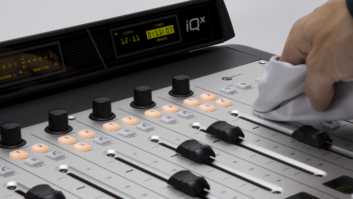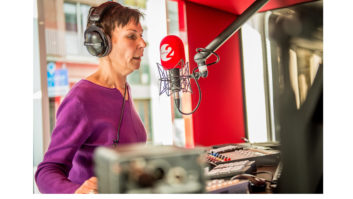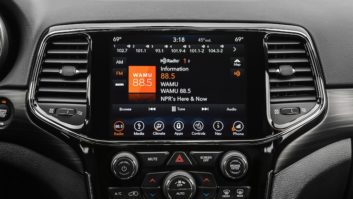The author chairs the Department of Journalism and Media Studies at Lehman College/City University of New York in New York.
As choices for information and entertainment continue to expand and evolve, what will become of our living room centerpiece?
It was a radio and then a television, and now many consumers have crossed the threshold to a “smart TV” that “talks” to the user’s smart speaker, laptop and portable devices, opening up a flood of audiovisual entertainment from all over the world. This also brings with it an unparalleled level of interactivity. It can be everything that its electronic ancestors were and more, but the fact that media consumption is now such a personal experience means that the mainstream power houses of mass media must rethink whether they are still creating and fueling the development of popular culture as they did in past generations.
Is there still a mass media experience that people share because they are hearing or viewing “what’s on?” Radio manufactures used aesthetics to fight for a place in the living room, similar to the way that flatter TV screens with high gloss piano black, chrome and glass are proudly displayed instead of being hidden in television cabinets. Since they are no longer the hefty, black plastic packages that require a large steel bracket just to keep them anchored to a wall, they have secured their place out in the open as the modern storytelling and entertainment machines.
Early radio created a sensation, often providing premium entertainment on an equal opportunity basis, whether listeners were in major cities or one horse towns. Radio broadcasting made it all seem as if it were magic. The radios themselves were beautiful living room centerpieces that sometimes featured custom designed artwork that celebrated the programming that they brought into the living room. Looking back at the birth of broadcasting and the ways in which radios found their place in the living room may provide some valuable considerations when planning to reach an audience in the immediate future. Whether it was in the 1930s or just last week, new media technology that arrives in the home as a glowing curiosity full of promise, seemingly limitless possibilities and even a dash of mystery is quickly embraced by early adopters who proudly display the shiny new knobs (if there are any now) and glowing displays. It’s much like the families who were the first on their block to bring home a radio, instead of listening to a phonograph or gathering around a piano as their neighbors did.

Atwater Kent breadboard radio (1923)
Of course, some of that enthusiasm for rushing radios into the living room can be attributed to people being captivated by the wonder of voices and music arriving almost magically out of thin air, especially in places where big-name entertainment was not readily available in person. It is clearly more challenging now to solidify a certain media entity or even medium as a centerpiece of popular culture with audience attention fragmented among so many new and traditional media. Teaching new generations of students about media content and practices is evolving constantly, but the focus is often more on strategy, rules, ratings and delivery methods since the “wonder” of a new technology is now often replaced by an expectation of immediacy and interactivity that targets the particular interests of audience members.

Primitive radios of the 1920s.
As sure as integrating desired technology into the home involved family decision making in the early 20th century, the reality of whether a different entertainment potential really merits a place for a new device is still an issue. Just as many couples had a “not in my living room” conversation in the late 1920s and into the 1930s about early radios that appeared to be laboratory experiments full of glowing tubes, large Bakelite knobs, wires, and antenna arrays that might stretch out of a window, the present day conversation has its own 21st century variations.

Emerson Snow White radio model 247 1939

Arvin Hopalong Cassidy model 441T radio (1950)
The early solution was to make radio receivers highly ornate with attractive cabinets, patterns of wood inlays, decorator colors or even gold leaf scenes of angels blowing trumpets as if the broadcasts it received emanated from Heaven itself. Novelty radios were based on favorite characters of the era such as Mickey Mouse, Hopalong Cassidy and Snow White or special events such as the 1939 World’s Fair. Radio delivered popular culture, but also helped create it with devices that encouraged listeners to feel as if they were part of the story. Why just listen to the serial western stories of Hopalong Cassidy when somebody could actually own a radio with the fictional cowboy’s image on the front of it? It was also common for manufactures to offer a less expensive “children’s” radio that allowed young people to immerse themselves in an experience that could establish a lifetime of listening habits.

Philco Grandfather clock radio (mid 1930s)

Stewart Warner Porto Baradio (1941)
For those who preferred a less obtrusive approach, another option for integrating radios into the home was to literally hide them in furniture such as end tables, grandfather clocks, faux fireplaces and lamps, or to make them part of oddly multipurpose objects such as a “radio bar” complete with tuning knobs and racks of shot glasses.
One of the reasons that radios occupied such a special place in living rooms in the early days of broadcasting is that the home was almost exclusively the radio’s sole domain. They delivered news with unprecedented immediacy, made radio announcers seem as if they were virtual friends of the family and could conjure up a favorite song. So-called “portable” radios of the 1920s were only portable in the sense that anyone who was strong enough could carry a radio, but with great effort and expense. The term “portable” is far from specific since a grand piano could be portable under the right circumstances. While radio listeners may now easily hear broadcasts, web streams and podcasts at work or during their commute, that was seldom the case in the beginning of the portable radio era. For those who did hear radio programs outside of the home, it was generally just the radio owner and possibly those in the immediate vicinity.

RCA Radiola 24 Portable (1923)

DeForest radio (early 1920s)
For most people, traveling with a radio was hardly spontaneous. Imagine carrying a device that had a wood or leatherette exterior, was sensitive to changing weather conditions, was full of glass tubes, generated heat and depleted specially-designed batteries very quickly. You could drop it, shatter it, melt it or dump corrosive acid out of the back of it. In the early days, a “portable” radio was nearly as large as a modern-day microwave oven. Battery-powered radios were often known as “farm” radios because they would be used in rural areas in which electrical outlets were scarce.
Bringing along this early form of electronic media was a decision reserved for a special occasion. The early models required as many as three different kinds of batteries known as “A,” “B” and “C” types in just one radio. It is very likely that some portable radios spent more time in garages and basements after families faced the reality of paying for batteries that were so easily depleted. An added risk came with the fact that batteries could become damaged and leak. Radio manufacturers responded as technology progressed by designing devices that consumed less power and eventually produced radios that were able to convert the alternating current of residential electrical service into the appropriate direct current and voltage for the device. All the while, battery manufacturers that remained in business improved their products and portable radios became more user-friendly and economical instead of just being extravagant toys for people of means.

“The Milkman Tunes In At Milking Time” (1923) Courtesy Library of Congress – LC-USZ62-60682
With portability no longer being an issue in the decades that followed, the very thought of planning one’s day around radio programming may be surprising to modern media users, but the lack of portability of receiving devices really did mean that a radio listeners would often schedule their listening time. Of course, this concept later extended to TV and the idea of being at the mercy of a programming schedule rapidly disappeared when videocassette recorders, digital video recorders and on-demand programming changed audience habits forever.
The earliest radio listening was sometimes a solitary experience, much like the portable music player experience now in which a world of entertainment only exists in the ear buds of the user. Since some of the first radios only had sufficient amplification to power one or two pairs of cumbersome earphones, there was little opportunity to experience entertainment together until the mid-1920s when technological innovations led to a small speaker either contained in the radio or a large and often heavy separate speaker. Once again, in order to beautify the technology, separate speakers often featured artwork on a cloth cover or an ornate wooden cover.

Tower “Adventurer” speaker by Tower Manufacturing Co.(1926)

RCA Radiola 103 Tapestry Floral speaker (1925)
Looking back at the years immediately following the first radio boom, television in the 1940s was still just a few steps away from a laboratory experiment. It came packaged in a gigantic piece of furniture that offered a 4-inch screen of low-resolution black and white video. Even when it shrunk to a size that might barely qualify as “table top,” TVs were heavy pieces of equipment and the tiny, blurry picture remained. A television offered limited hours of programming and, with growing pains similar to those first experienced by its older radio cousin, the medium was still trying to establish what qualified as “good” television that was worth watching while radio series were still so popular. Its unprecedented newness, though, allowed for the co-existence with radio and the allocation of more floor space in the living room before radios and TVs began merging into console entertainment centers, just as radios and record players became integrated less than twenty years earlier. Television design aesthetics, though, never really escalated to the same level of beauty contests typical of radio manufactures.

1940s tabletop televisions.
With the rise of “high-fidelity” radios and record players in the 1950’s, those who sought the highest levels of audio quality were able to indulge themselves with stacks of electronic components that included glowing tubes, early transistors, graphic equalizers with lights on the end of each fader and a series of devices that would detect, pre-amplify and then amplify signals to perfection through enormous speakers. As was the case with the rich cabinetry, brightly colored plastics and Art Deco designs of early radios, high-fidelity audio gear showed that consumers were once again ready to build glowing shrines of home entertainment that could be admired while enjoying the best in audio entertainment.

Zenith 8-S-463 console radio (1939)

Sparton “sled” model 558B (1937)

Plastic radio assortment (1950s)
Recalling life in college dormitories from the 1960s to around even the beginning of the 90s, some people will smile as they remember a dorm mate whose room would periodically become the center of attention. That was the inner sanctum of entertainment that housed a stereo system that could send low-frequency shockwaves a few floors down or make people’s ears buzz with the sizzle of an electronic keyboard or a blistering guitar riff by way of the radio, vinyl or recording tape. In the midst of this, you might have found a group playfully enjoying some audio geekery while attempting to determine who could really hear the 20,000 Hertz sounds at the upper end of human perception. During such a scenario, the audio system’s owner would, of course, watch with great satisfaction because he or she could deliver that experience.
Media have become so entwined with the social and professional lives of users that the struggle to gain acceptance in the living room has been replaced by a fight for relevance in one’s daily rituals and lifestyle choices. There is a relatively new freedom that may be found in this, since it the traditional model of the dominant family members “ruling the remote” or “the radio dial” or deciding what print publications make it into the home has faded. The more the media consumer reaches out for his or her own unique blend of entertainment, the more that person is removed from group experiences.

Vintage HiFi devices of the 1960s
At the very least, consumers expect predictable results at an acceptable level of quality. In addition, broadcasters already know that every minute a person accepts idle amusement such as watching an internet video of a cat chasing a laser pointer’s bright red dot is a minute that a potential audience member is not listening to the radio or watching television. Media prognosticators have many good reasons to huddle about the convergence of computers, audio systems and video displays.
In the present day, the effect of preset buttons for internet audio streams working as effortlessly as those for broadcast stations is a game changer with wireless networks in the home and many automobiles using a cell phone’s data connection, despite its potential expense, to deliver the same results. Even the lack of a tuning knob on most devices means that the possibility of a station being discovered as a user tunes past the frequency is greatly diminished. One interesting effect that would have been impossible in decades past is that online content generated by a single person, even as hobby, is able to exist side-by-side with programming delivered by traditional media giants if a listener or viewer chooses to allow it to exist on his or her receiving device.
As with all new technologies, the former centerpiece of family entertainment may have already become an old friend that finds a place in a basement or the den when the next “big thing” comes along. There are many lessons that can be learned from the era following the birth of radio when broadcasters and radio manufacturers realized that their products needed to be beautiful and deliver stimulating programming that demanded attention if they were going to cross the threshold and gain acceptance in the living room. They nurtured and achieved human connections on an emotional level through audience engagement. In fact, radios became much like fireplaces where families would gather to listen to their favorite radio programs. Now, can anything be done to produce a new form of “magic” that will truly captivate a mass audience with a “next big thing” that will actually last or will everyone be, in a sense, alone together with individualized media content?
Perhaps the elusive answers to these 21st century questions may be inspired by a thoughtful look at how the radio’s arrival in the living room transformed the world throughout the 20th century. It used to be pointless when audience members reacted by talking back to their radios and televisions, but in this century, people expect to hear an answer.
Tom O’Hanlon is an associate professor and chair of the Department of Journalism and Media Studies at Lehman College/City University of New York in New York City. He is also a radio broadcaster with CBS Radio in New York and is frequently heard on WCBS NewsRadio 880.
Special thanks to Stan Jacobs, Yorktown, N.Y., and Peter Kanze, Waverly, N.Y., for making their personal collections available. All photos shown are by the author except “The Milkman Tunes In At Milking Time” – Courtesy Library of Congress Archives.











